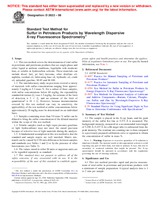Potrebujeme váš súhlas na využitie jednotlivých dát, aby sa vám okrem iného mohli ukazovať informácie týkajúce sa vašich záujmov. Súhlas udelíte kliknutím na tlačidlo „OK“.
ASTM D2622-98
Standard Test Method for Sulfur in Petroleum Products by Wavelength Dispersive X-ray Fluorescence Spectrometry
Automaticky preložený názov:
Štandardná skúšobná metóda pre síru v ropných produktoch podľa Vlnová dĺžka disperzné X - ray fluorescenčná spektrometria
NORMA vydaná dňa 10.4.1998
Informácie o norme:
Označenie normy: ASTM D2622-98
Poznámka: NEPLATNÁ
Dátum vydania normy: 10.4.1998
Kód tovaru: NS-20928
Počet strán: 6
Približná hmotnosť: 18 g (0.04 libier)
Krajina: Americká technická norma
Kategória: Technické normy ASTM
Anotácia textu normy ASTM D2622-98 :
Keywords:
Oils-fuel, ICS Number Code 75.080 (Petroleum products in general)
Doplňujúce informácie
| 1. Scope | ||||||||||||||||
|
1.1 This test method covers the determination of total sulfur in petroleum and petroleum products that are single-phase and either liquid at ambient conditions, liquifiable with moderate heat, or soluble in hydrocarbon solvents. These materials can include diesel fuel, jet fuel, kerosine, other distillate oil, naphtha, residual oil, lubricating base oil, hydraulic oil, crude oil, unleaded gasoline, M-85 and M-100. 1.2 The interlaboratory study on precision covered a variety of materials with sulfur concentrations ranging from approximately 3 mg/kg to 5.3 mass %. For a subset of these samples, with sulfur concentrations below 60 mg/kg, the repeatability standard deviation (Sr) was 1.5 mg/kg. An estimate of the limit of detection is 3 X Sr , and an estimate of the limit of quantitation 2 is 10 X Sr. However, because instrumentation covered by this test method can vary in sensitivity, the applicability of the test method at sulfur concentrations below approximately 20 mg/kg must be determined on an individual basis. 1.3 Samples containing more than 5.0 mass % sulfur can be diluted to bring the sulfur concentration of the diluted material within the scope of this test method. 1.4 Volatile samples (such as high vapor pressure gasolines or light hydrocarbons) may not meet the stated precision because of selective loss of light materials during the analysis. 1.5 A fundamental assumption in this test method is that the standard and sample matrix are well matched. Matrix mismatch can be caused by C/H ratio differences between samples and standards (see Tables 1 and 2) or by the presence of other heteroatoms (see Table 3). 1.6 The values stated in either SI units or angstrom units are to be regarded separately as standard. 1.7 This standard does not purport to address all of the safety concerns, if any, associated with its use. It is the responsibility of the user of this standard to establish appropriate safety and health practices and determine the applicability of regulatory limitations prior to use. For specific hazard information, see Note 1. |
||||||||||||||||
| 2. Referenced Documents | ||||||||||||||||
|
Odporúčame:
Aktualizácia zákonov
Chcete mať istotu o platnosti využívaných predpisov?
Ponúkame Vám riešenie, aby ste mohli používať stále platné (aktuálne) legislatívne predpisy
Chcete vedieť viac informácií ? Pozrite sa na túto stránku.




 Cookies
Cookies
